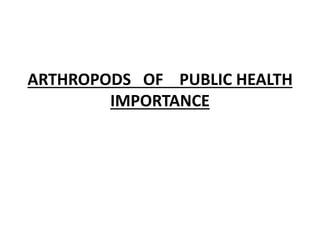ARTHROPODS OF PUBLIC HEALTH IMPORTANCE.pptx
•Als PPTX, PDF herunterladen•
0 gefällt mir•641 views
This document discusses several arthropods of public health importance including mosquitoes, flies, fleas, lice, and bugs. It focuses on the four main genera of mosquitoes - Anopheles, Culex, Aedes, and Mansoniades. The life cycle of mosquitoes includes eggs, larva, pupa, and adult stages. Malaria is described as a life-threatening disease spread by the female Anopheles mosquito. Severe malaria can lead to complications like jaundice, seizures, organ failure, and even death. An integrated approach is needed for effective control of disease vectors.
Melden
Teilen
Melden
Teilen

Weitere ähnliche Inhalte
Was ist angesagt?
Was ist angesagt? (20)
Medical entomology "the need to know about little creatures"

Medical entomology "the need to know about little creatures"
CM 1.3 Agent Host and environmemtal factors ,epidemiological triad ,multi fac...

CM 1.3 Agent Host and environmemtal factors ,epidemiological triad ,multi fac...
Ähnlich wie ARTHROPODS OF PUBLIC HEALTH IMPORTANCE.pptx
Ähnlich wie ARTHROPODS OF PUBLIC HEALTH IMPORTANCE.pptx (20)
Flies and mosquito related medical conditions and vector control ppt

Flies and mosquito related medical conditions and vector control ppt
Entomological presentation for traininig purpose.pptx

Entomological presentation for traininig purpose.pptx
Nematode .......parasites of human and further phylogenetic consideration

Nematode .......parasites of human and further phylogenetic consideration
Human resources section_8-textbook_on_public_health_and_community_medicine

Human resources section_8-textbook_on_public_health_and_community_medicine
Kürzlich hochgeladen
Faculty Profile prashantha K EEE dept Sri Sairam college of Engineering

Faculty Profile prashantha K EEE dept Sri Sairam college of EngineeringSri Sairam College Of Engineering Bengaluru
Mattingly "AI & Prompt Design: Large Language Models"

Mattingly "AI & Prompt Design: Large Language Models"National Information Standards Organization (NISO)
31 ĐỀ THI THỬ VÀO LỚP 10 - TIẾNG ANH - FORM MỚI 2025 - 40 CÂU HỎI - BÙI VĂN V...

31 ĐỀ THI THỬ VÀO LỚP 10 - TIẾNG ANH - FORM MỚI 2025 - 40 CÂU HỎI - BÙI VĂN V...Nguyen Thanh Tu Collection
Kürzlich hochgeladen (20)
Blowin' in the Wind of Caste_ Bob Dylan's Song as a Catalyst for Social Justi...

Blowin' in the Wind of Caste_ Bob Dylan's Song as a Catalyst for Social Justi...
Faculty Profile prashantha K EEE dept Sri Sairam college of Engineering

Faculty Profile prashantha K EEE dept Sri Sairam college of Engineering
Mattingly "AI & Prompt Design: Large Language Models"

Mattingly "AI & Prompt Design: Large Language Models"
4.11.24 Mass Incarceration and the New Jim Crow.pptx

4.11.24 Mass Incarceration and the New Jim Crow.pptx
4.16.24 21st Century Movements for Black Lives.pptx

4.16.24 21st Century Movements for Black Lives.pptx
31 ĐỀ THI THỬ VÀO LỚP 10 - TIẾNG ANH - FORM MỚI 2025 - 40 CÂU HỎI - BÙI VĂN V...

31 ĐỀ THI THỬ VÀO LỚP 10 - TIẾNG ANH - FORM MỚI 2025 - 40 CÂU HỎI - BÙI VĂN V...
Q-Factor HISPOL Quiz-6th April 2024, Quiz Club NITW

Q-Factor HISPOL Quiz-6th April 2024, Quiz Club NITW
Beauty Amidst the Bytes_ Unearthing Unexpected Advantages of the Digital Wast...

Beauty Amidst the Bytes_ Unearthing Unexpected Advantages of the Digital Wast...
BIOCHEMISTRY-CARBOHYDRATE METABOLISM CHAPTER 2.pptx

BIOCHEMISTRY-CARBOHYDRATE METABOLISM CHAPTER 2.pptx
ARTHROPODS OF PUBLIC HEALTH IMPORTANCE.pptx
- 1. ARTHROPODS OF PUBLIC HEALTH IMPORTANCE
- 2. ARTHROPODS OF PUBLIC HEALTH IMPORTANCE CLASS INSECTA: MOSQUITOES FLIES FLEAS LICE BUGS
- 3. MOSQUITOES Important group of Mosquitoes in India that spread diseases are four in number 1. Anopheles 2. Culex 3. Aedes 4. Mansoniades
- 20. 4 differences among genera of adult mosquito The important genera of mosquitoes that are of public health importance are Anopheles, Aedes, and Culex. The stages of a mosquito’s life cycle are as follows: 1. Eggs 2. Larva 3. Pupa 4. Adult mosquito
- 24. Egg - hatches when exposed to water.
- 25. Larva - (plural: larvae) "wriggler" lives in water; molts several times
- 26. • Pupa - (plural: pupae) "tumbler" does not feed; stage just before emerging as adult. • Adult - flies short time after emerging and after its body parts have hardened.
- 29. Malaria Mal’ aria means “bad air” (Originally thought to be caused by foul air) A life-threatening protozoan disease 40% of the world’s population is at risk of getting the disease 80% of population in India lives in low malaria endemic region 80% of malaria burden in India is confined to 20% of population that live in malaria endemic region in India
- 30. Female anopheles mosquito is the vector o P. vivax o P. Falciparum The mosquito breeds in polluted water bodies, brackish water, wells, cisterns, fountains, overhead tanks etc. Mosquito bites during night time
- 33. Severe Malaria - consequences -• Jaundice -• Seizure -• Bleeding problems -• Liver failure -• Kidney failure -• Multi organ failure -• “Death” also as a possible outcome
- 40. Integration of various potential methods for control of disease vectors
- 41. Flies
- 47. Sand fly